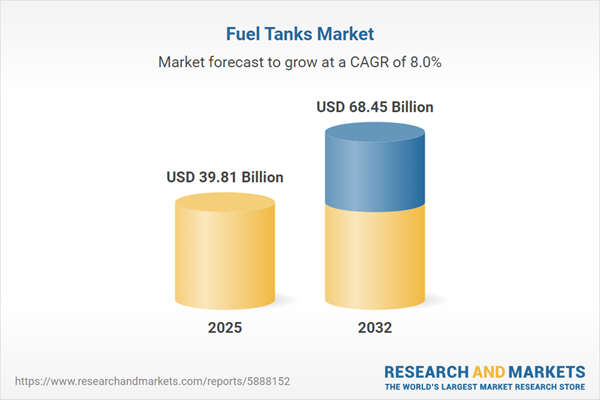Speak directly to the analyst to clarify any post sales queries you may have.
The global fuel tanks market is transforming as regulatory requirements, technology advances, and sustainability priorities converge. Senior executives are focusing on robust, compliant fuel storage strategies that meet evolving operational standards and ensure readiness for regulatory and economic shifts.
Fuel Tanks Market Snapshot
The fuel tanks market is experiencing significant growth as industries adjust to changing compliance landscapes and rising efficiency demands. In 2024, the market was valued at USD 36.86 billion, and is projected to reach USD 68.45 billion by 2032, reflecting a strong compound annual growth rate. Factors driving this expansion include the increasing complexity of operational requirements within energy, transportation, automotive, and marine sectors. Modern fuel storage solutions are being adopted to enhance compliance, improve energy efficiency, and optimize large-scale operations. Tailored engineering, advanced materials, and integrated systems are helping organizations boost performance and strengthen market positioning amid competitive pressures.
Scope & Segmentation of the Fuel Tanks Market
This report offers detailed analysis of the key sectors and trends shaping the fuel tanks market. Strategic segmentation helps senior leaders make proactive investment and technology decisions suited to dynamic industry conditions.
- Applications: Aerospace, agricultural machinery, marine vessels, commercial vehicles, passenger cars, oil and gas sites, and power generation facilities each present unique regulatory and durability challenges, requiring targeted tank solutions that balance compliance with operational needs.
- Fuel Types: Diesel, jet fuel, and gasoline storage each demand adherence to sector-specific safety, performance, and compliance standards.
- Material Types: Aluminum, steel, plastic, carbon fiber, and glass fiber composites offer varying benefits, such as reduced weight, improved corrosion resistance, and long service life, all while meeting compliance requirements.
- Capacity Brackets: Tank options range from compact units below 50 liters for specialized roles to large systems above 5,000 liters, supporting a diverse array of industrial and commercial applications.
- Distribution Channels: Options include OEM partnerships, aftermarket distributors, retail networks, and digital procurement platforms, allowing organizations to optimize supply chain management with benefits such as streamlined inventory and enhanced aftersales support.
- Regional Coverage: The report covers the Americas, Europe, Asia-Pacific, Middle East, and Africa, spotlighting how local regulatory environments and differing supply chain approaches demand tailored sourcing and logistics strategies.
Key Takeaways for Senior Decision-Makers
- Use of composite materials and sensor integration is advancing tank durability, oversight, and predictive maintenance, serving new and established industry needs.
- Collaboration between manufacturers, suppliers, and regulators accelerates the rollout of innovative tank solutions in line with changing standards and technology requirements.
- Electrification trends in mobility are guiding the development of flexible tank systems for broader transportation and industrial scenarios.
- Digital manufacturing and data analytics are supporting precise customization and lifecycle monitoring, empowering leaders in asset management and strategic planning.
- Ongoing policy adjustments and compliance updates emphasize the importance of agile supply chains that can quickly respond to regulatory change.
- Coordinated supply chain solutions are helping minimize the impacts of disruption and ensure regulatory compliance across stringent environments.
Tariff Impact: Managing Costs and Supply Chain Resilience
Rising tariffs on essential materials such as steel, aluminum, and composites are increasing production costs and supply chain pressures in the fuel tank industry. Organizations are responding with strategies like increasing local sourcing, investing in recycling, and refining inventory management. These adaptive logistics approaches are reinforcing operational continuity and minimizing vulnerability to changing global trade conditions.
Methodology & Data Sources
This report is based on structured interviews with engineers, suppliers, distributors, and compliance experts. Additional data is gathered from executive surveys, peer-reviewed industry research, patent filings, and regulatory reviews to provide a well-rounded view of the sector.
Why This Fuel Tanks Market Report Matters for Senior Leaders
- Supports procurement and supply chain strategy by clarifying growth trends and regulatory risk, aiding informed investment and operational planning.
- Highlights the importance of leveraging advanced storage solutions and collaboration to implement business models that are resilient and future-ready.
- Delivers reliable regional and global market intelligence, empowering decision-makers to confidently plan for changing compliance requirements and business growth.
Conclusion
This report provides actionable insight for executives to set priorities, strengthen compliance, and pursue sustainable growth in the changing fuel tanks sector.
Additional Product Information:
- Purchase of this report includes 1 year online access with quarterly updates.
- This report can be updated on request. Please contact our Customer Experience team using the Ask a Question widget on our website.
Table of Contents
3. Executive Summary
4. Market Overview
7. Cumulative Impact of Artificial Intelligence 2025
Companies Mentioned
The companies profiled in this Fuel Tanks market report include:- Plastic Omnium S.A.
- TI Fluid Systems plc
- YAPP Automotive Products Co., Ltd.
- Kautex Textron GmbH
- Frauenthal Automotive GmbH
Table Information
| Report Attribute | Details |
|---|---|
| No. of Pages | 188 |
| Published | October 2025 |
| Forecast Period | 2025 - 2032 |
| Estimated Market Value ( USD | $ 39.81 Billion |
| Forecasted Market Value ( USD | $ 68.45 Billion |
| Compound Annual Growth Rate | 8.0% |
| Regions Covered | Global |
| No. of Companies Mentioned | 6 |









